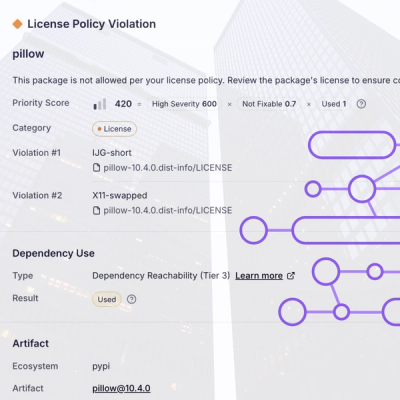
Research
/Security News
Critical Vulnerability in NestJS Devtools: Localhost RCE via Sandbox Escape
A flawed sandbox in @nestjs/devtools-integration lets attackers run code on your machine via CSRF, leading to full Remote Code Execution (RCE).
org.webjars.npm:shady-css-parser
Advanced tools
Supply Chain Security
Vulnerability
Quality
Maintenance
License
The motivation for Shady CSS Parser is to provide a fast, small and flexible CSS parser suitable for facilitating runtime parsing and transformation of CSS. The Polymer library and the Polymer Designer tool are both example cases where fast and flexible CSS parsing and transformation is a critical feature.
With node and npm installed, run the following command:
npm install shady-css-parser
Run the following commands from the project root:
npm run build
This will create a dist directory containing distributable artifacts.
import * as shadyCss from 'shady-css-parser';
const css = 'body { color: red; }';
const parser = new shadyCss.Parser();
const ast = parser.parse(css);
/* Step 1: Inherit from NodeFactory */
class CustomNodeFactory extends shadyCss.NodeFactory {
/*
* Step 2: Implement a custom node factory method. Here we override the
* default factory for Expression nodes
*/
expression(text) {
if (/^darken\(/.test(text)) {
return {
type: 'darkenExpression',
color: text.replace(/^darken\(/, '').replace(/\)$/, ''),
};
} else {
return super.expression.apply(this, arguments);
}
}
}
const css = 'body { color: darken(red); }';
/* Step 3: Instantiate a Parser with an instance of the specialized
* CustomNodeFactory */
const parser = new shadyCss.Parser(new CustomNodeFactory());
const ast = parser.parse(css);
const stringifier = new shadyCss.Stringifier();
stringifier.stringify(ast);
Note: the built-in Parser and Stringifier discard most insignficiant whitespace from parsed CSS.
/* Step 1: Inherit from Stringifier. */
class CustomStringifier extends shadyCss.Stringifier {
/**
* Step 2: Implement a stringification method named after the type of the node
* you are interested in stringifying. In this case, we are implementing
* stringification for the Darken Expression nodes we implemented parsing for
* above.
*/
darkenExpression(darkenExpression) {
// For the sake of brevity, please assume that the darken function returns
// a darker version of the color parameter:
return darken(darkenExpression.color);
}
}
/* Step 3: Use the custom stringifer: */
const stringifier = new CustomStringifier();
const css = stringifier.stringify(ast);
.container {
--nog: blue;
}
{
"type": 1, /* stylesheet */
"rules": [
{
"type": 4, /* ruleset */
"selector": ".container",
"rulelist": {
"type": 7, /* rulelist */
"rules": [
{
"type": 6, /* declaration */
"name": "--nog",
"value": {
"type": 5, /* expression */
"text": "blue"
}
}
]
}
}
]
}
ruleset {
--mixin-name: {
/* rules */
};
}
{
"type": 1, /* stylesheet */
"rules": [
{
"type": 4, /* ruleset */
"selector": "ruleset",
"rulelist": {
"type": 7, /* rulelist */
"rules": [
{
"type": 6, /* declaration */
"name": "--mixin-name",
"value": {
"type": 7, /* rulelist */
"rules": [
{
"type": 2, /* comment */
"value": "\/* rules *\/"
}
]
}
}
]
}
}
]
}
.title {
@apply(--my-toolbar-title-theme);
}
{
"type": 1, /* stylesheet */
"rules": [
{
"type": 4, /* ruleset */
"selector": ".title",
"rulelist": {
"type": 7, /* rulelist */
"rules": [
{
"type": 3, /* at rule */
"name": "apply",
"parameters": "(--my-toolbar-title-theme)",
"rulelist": null
}
]
}
}
]
}
/* unclosed
@fiz {
--huk: {
/* buz */
baz: lur;
};
}
{
"type": 1, /* stylesheet */
"rules": [
{
"type": 2, /* comment */
"value": "\/* unclosed\n@fiz {\n --huk: {\n \/* buz *\/"
},
{
"type": 6, /* declaration */
"name": "baz",
"value": {
"type": 5, /* expression */
"text": "lur"
}
},
{
"type": 8, /* discarded */
"text": "};\n"
},
{
"type": 8, /* discarded */
"text": "}"
}
]
}
/* before */
body {
margin: 0;
padding: 0px
}
/* after */
body{margin:0;padding:0px;}
/* before */
@import url('foo.css');
@font-face {
font-family: foo;
}
@charset 'foo';
/* after */
@import url('foo.css');@font-face{font-family:foo;}@charset 'foo';
/* before */
:root {
--qux: vim;
--foo: {
bar: baz;
};
}
#target {
gak: var(--qux);
@apply(--foo);
}
/* after */
:root{--qux:vim;--foo:{bar:baz;};}#target{gak:var(--qux);@apply (--foo);}
FAQs
WebJar for shady-css-parser
We found that org.webjars.npm:shady-css-parser demonstrated a not healthy version release cadence and project activity because the last version was released a year ago. It has 0 open source maintainers collaborating on the project.
Did you know?

Socket for GitHub automatically highlights issues in each pull request and monitors the health of all your open source dependencies. Discover the contents of your packages and block harmful activity before you install or update your dependencies.

Research
/Security News
A flawed sandbox in @nestjs/devtools-integration lets attackers run code on your machine via CSRF, leading to full Remote Code Execution (RCE).

Product
Customize license detection with Socket’s new license overlays: gain control, reduce noise, and handle edge cases with precision.

Product
Socket now supports Rust and Cargo, offering package search for all users and experimental SBOM generation for enterprise projects.